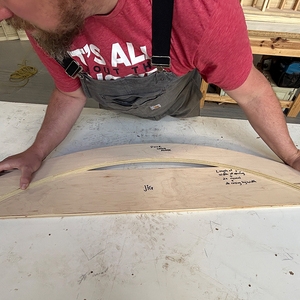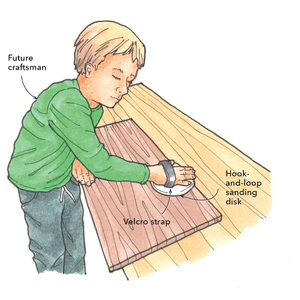*
The next several posts include screen shots from two different drawing programs. One program is AutoCAD (release 14), and the other is Broderbund’s 3-d Home Architect (version 4).
3-d Home Architect can be purchased from WalMart, Office Depot, OfficeMax, Staples, etc. for about $40.
AutoCAD….well, if you have to ask, you can’t afford it. But educational copies of non-current versions may be found for less than $200.
3-d Home Architect is easy to learn, but does not produce very accurate drawings and has difficulties with roof lines.
AutoCAD does everything, but the learning curve is steep.
I first use 3-d Home Architect to play around and get ideas. Then I draw it again in three dimensions using AutoCAD for accuracy.
The screen shots are on the next several posts.



















Replies
*
This screen shot shows a 3d Home Architect floor plan. This file is rather large (136K). The drawing isn't complete, but it shows what can be done.
*This shows a 3-d Home Architect view of the kitchen area (68K).
*This is a 3-d Home Architect view of the garage area (79K). The lower right corner shows the fender of a car in the garage.Note the errors in the rendition. The top of the shelves appears transparent, the stairs aren't quite right, and there's grass showing below the door to the right of the stairs. All things considered, it does a pretty good job for the money.
*This large (157KB) file shows an AutoCAD drawing of the same house viewed from the South West. Some parts of the framing aren't complete in this drawing.Zooming in on this drawing using AutoCAD allows me to see both the interior and exterior surfaces of a 3" support pipe in the basement. Zooming out allows me to see the property boundaries of the 110 acres surrounding the house.
*And here's another large AutoCAD screen shot (246KB) showing the house from the opposite corner and somewhat closer.The dimensions of any of the boards shown can be easily obtained using AutoCAD. Dimensions in 3-d Home Architect aren't so easily obtained and aren't as accurate. Wall thicknesses are 4" (or 6", 8", 12", etc.), but not 3.5".
*Ted - the last educational version of Autocad that I purchased (v 13) they required that to run the program, you must supply them with information showing that you are a valid educational user before they give you a "key" that allows the program to run. I work for an educational institution, so I should qualify, but I haven't gone through the hassle yet.
*You can get the non-educational (not that you won't learn anything, that it's licensed for non-school use) version of AutoCad LT2000i for under $600. This is very widely used by professional architects, kinda the F-150 of CAD programs. The full AutoCad program is more of an eighteen wheeler, sold mostly to big corporate accounts. The problem with all the non-AutoDesk products is that you'll have a lot of grief if you have to get your drawings plotted on big pieces of paper by a plotting service. The service vendors all use AutoDesk software (LT is sufficient for plotting from files created by the full expensive version). But AutoDesk doesn't release their file spec, so all the others that claim to output a .DWG file are using a reverse engineered format. The .DWG format is a monster. Little wonder that nobody else ever really gets it right.If you've never used CAD, you can't imagine how many hundreds or even thousands of hours you'll spend at it. So if you think there's any possibility you'll ever want to get your drawings plotted, go with LT from the beginning. I wish I had.-- J.S.
*How about Form-Z? I've still haven't tried to plot a drawing with this program--just printing--so I don't know a thing about that yet. Same issues or not?In all other respects, it's a great program to work with. It can, for all intents and purposes, be used for 2-D drafting, but it can also be used for 3-D rendering and animation.I think it's easier to work with than Autocad--it's got a better interface, it's more intuitive to use, and it's a lot more versatile. I definitely prefer using Form-Z for 3-D than A-Cad.It's a helluva lot cheaper, too. P.S. Don't ever buy the student version of Autocad--yes, you do have to provide proof that you're either an educator or a full-time student to eveni installthe software. Fine, I'm a student. But what pisses me off is the fact that every file created with it will print "Produced By An Autodesk Educational Product" along all four edges of the paper when plotted. Pretty sucky trick for a drafting program that costs $350.00.
*Anthony --Have your plotting service output your drawings on erasable vellum. Erase those words and put them thru the diazo machine and nobody will know.-- J.S.
*I have a student version that is just so I can learn it - I actually use Softplan - that came with the autodesk book AC2000 for Architecture for about $59. It has to be reinstalled every thirty days so no saving files for long.
*being as I've been in engineering since around '88 I've worked with Acad alot. I started out with the dos version r10 and have used r11, r12, r13, r14 and Acad2000. if you think the new windows versions have a learning curve try using the dos based package! Funny thing is now when I run the program I have one hand on the mouse and the other on the keyboard. Originally most of the commands were run with typed commands and the program still recognizes most of them. so its easier for example to hit Z space bar A space bar to do a 'zoom all' than running the mouse around the screen looking for the icon.(the space bar acts as if you hit enter for most commands) Anyway I ended up with a full blown version of r14 for keeps as a result of doing alot of work at home for previous employers and it has definitely come in handy for all kinds of stuff.
*The only thing scarier than builders drawing on a computer (well, ok except for Mike and Joe) is architects building.Jeff
*Hey Jeff here's one even scarier... An electrical engineer building stuff! (insert sinister laughter here)
*Right! - ROFWSL (Rolling On the Floor With Sinister Laughter) - Luka probably has a sinister.wav for the occasion.PS - My first CAD computer was a Sun 3/60 with 1 MB of RAM and a 60 MB hard drive. It was the size of a filing cabinet. I'd hate to tell you what we paid for it, but I can remember the firm buying a 5 MB RAM upgrade (the circuit board was 8 1/2 x 11) for about (gulp) $5,000. Just think what that buys today ...
*
The next several posts include screen shots from two different drawing programs. One program is AutoCAD (release 14), and the other is Broderbund's 3-d Home Architect (version 4).
3-d Home Architect can be purchased from WalMart, Office Depot, OfficeMax, Staples, etc. for about $40.
AutoCAD....well, if you have to ask, you can't afford it. But educational copies of non-current versions may be found for less than $200.
3-d Home Architect is easy to learn, but does not produce very accurate drawings and has difficulties with roof lines.
AutoCAD does everything, but the learning curve is steep.
I first use 3-d Home Architect to play around and get ideas. Then I draw it again in three dimensions using AutoCAD for accuracy.
The screen shots are on the next several posts.